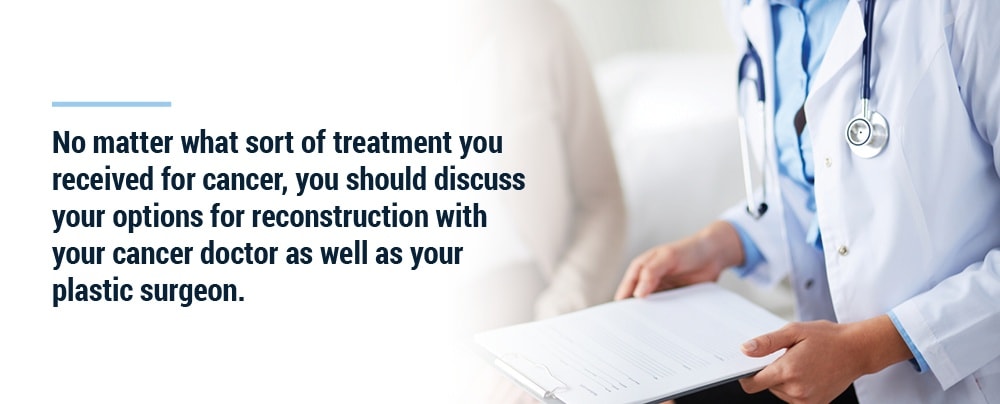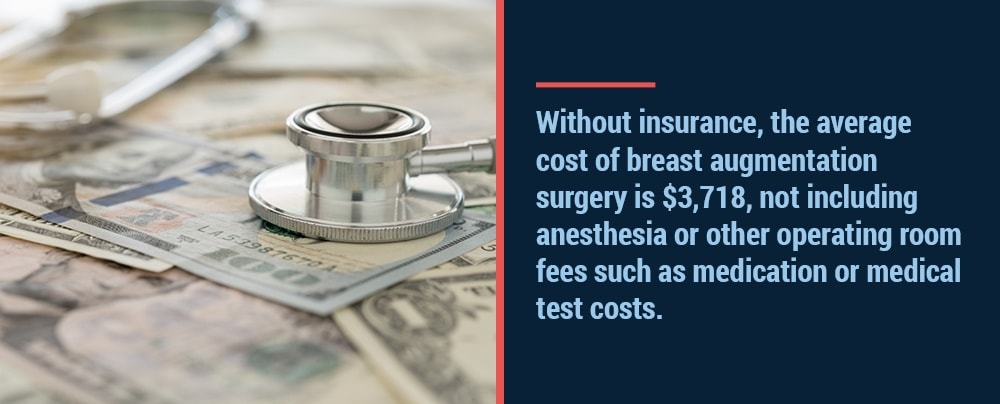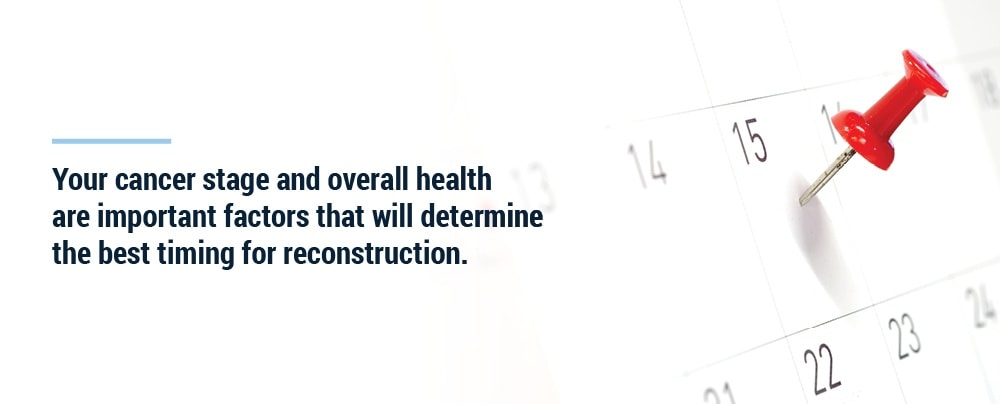Should I Have Breast Reconstruction After Mastectomy, Radiation or Lumpectomy?
Breast Reconstruction After Cancer
Breast cancer is a life-altering experience, and an all-too-common one. The American Cancer Society estimates that in 2018, over 266,000 new cases of invasive breast cancer will be diagnosed in women. Women have a one-in-eight chance of developing breast cancer over a lifetime.
Many women have plenty of questions to ask and decisions to make after a mastectomy, radiation, or a lumpectomy. One of those questions may be, “Should I have breast reconstruction?”
If you are currently in this position, know that there is no right or wrong answer to this question. The decision to have reconstruction surgery depends on both your physical and emotional needs, and every woman is different. You might have other questions too such as:
- Can I have breast reconstruction surgery after a lumpectomy, mastectomy, radiation, or chemotherapy?
- What factors should I consider?
- How long does it take to recover?
- How much does it cost?
- Will it increase the risk of cancer coming back?
After treatment, you can have breast reconstruction surgery if you feel it’s the right choice for you. If you feel uncertain, we hope to guide you to your decision in this post. We’ll look at the things you need to know about breast reconstruction after cancer and answer common questions to help you decide.
What Is Breast Reconstruction Surgery?
Breast reconstruction surgery refers to rebuilding the breast after a mastectomy or lumpectomy. Reconstruction may include adding breast implants or using tissue from another part of the body to rebuild the breast, also called a tissue flap procedure. Sometimes, a tissue flap and implant are combined to rebuild the breast.
Many times breast reconstruction occurs at the same time as a mastectomy, but some women may wait to have reconstruction surgery later on. Doctors might recommend waiting for reconstruction surgery until after radiation treatment is complete.
Some women choose against reconstruction surgery and instead opt for a prosthesis, or a breast form, which they can wear in their bra. Other women decide to live breast-free. What you choose depends on what’s important to you and the type of cancer surgery you had.
Benefits of Breast Reconstruction Surgery After Cancer Treatments
Cancer treatment might involve the removal of a breast, called a mastectomy. Some women undergo a lumpectomy, which involves removing a cancerous tumor from the breast. Both types of cancer treatment cause a change in breast appearance.
There is no wrong or right way to cope with a mastectomy or lumpectomy. It’s an emotionally difficult process and a part of cancer treatment many survivors must face. Breast reconstruction surgery might help some patients overcome the trauma of cancer and get them feeling good again.

In general, a woman might choose breast reconstruction surgery for the following benefits:
- To regain her breast shape
- To feel happier and more confident about herself and her body
- To avoid using a breast form
- Assist in clothes fitting more naturally once again
- To restore a balance between the two breasts
Factors to Consider With Breast Reconstruction Surgery After Cancer
As a survivor, your top priority is to stay cancer-free. It’s understandable if you do not feel ready to jump into surgery after cancer treatment, and you should take time to consider your best options. Reconstruction surgery may require several surgeries over a long period. Before you commit to a surgery schedule, it’s important to consider the following factors:
- Consider practicalities: Think about how surgery might impact your job or your ability to care for your family. Consider how multiple surgeries and recovery times will affect your future plans. Ask yourself if it is important to you to have balanced-looking breasts when you’re in public, such as in a swimsuit at a pool. Each woman will have different feelings about the effects of reconstruction surgery — allow your unique situation to offer guidance.
- Consider the impact of your treatment: If you had a lumpectomy, for example, it might have left your breasts in different shapes, and you may want them to be the same. Most women are content with their breast shape after a lumpectomy. However, 10 to 30 percent of women are not satisfied. Reconstruction may be the best option for you depending on how you feel after cancer treatment.
- Evaluate your overall health: Women with underlying conditions, such as circulation issues or diabetes, may take longer to heal from breast reconstruction surgery. That doesn’t mean you can’t go through with it, but you should take this into consideration. You will want to discuss the surgical risks related to any other medical conditions you are treated for such as high blood pressure, diabetes, and/or cardiovascular disease. You should also keep in mind that many surgeons recommend smokers quit both before and after surgery, to help the body recover more quickly.
- Consider your mental state: Many women find breast reconstruction after treatment helps them feel whole again. It’s a psychological edge they need moving forward. Other women need a break from surgeries and time to heal emotionally before considering breast reconstruction. Again, it’s all up to you. Be prepared to be flooded with an abundance of information from multiple physicians including a breast surgeon, a plastic surgeon, an oncologist, and possibly more. It’s understandably difficult to think too far into the future, but we encourage patients to try to picture themselves a year or more down the road and how they might feel with or without the feminine shape of breasts after undergoing treatment.
The Risks of Breast Reconstruction Surgery
As with any form of surgery, breast reconstruction carries certain risks. Although many of these risks are not common, it is still important to be aware of the possibilities and consider these factors when making a decision. A few of the risks during or shortly after surgery include:
- Bleeding
- Blood clots
- Infection where the surgery occurred
- Problems with healing
- Fatigue
- Issues with anesthesia
Problems that may arise later include:
- Necrosis, or tissue death of skin, fat or a tissue flap
- Changes in breast or nipple sensation
- Loss of sensation in the breast or nipple
- Loss of muscle strength where tissue was taken
- Arm changes/swelling on the side of the reconstructed breast
- Issues with the breast implant such as leakage, movement or scar tissue
- Uneven breasts
- Capsular contracture
Capsular contracture is one of the most common risks of breast implants. Capsular contracture means a scar, or capsule, forms around the implant. As the scar tightens, it squeezes the implant and can make the breast feel hard. Capsular contracture is often treated by removing the scar tissue, and possibly removing/replacing the breast implant.
Steps to Take Before Surgery
If you’ve decided breast reconstruction surgery is right for you, make sure to take these steps before surgery:
- Speak with your doctor: No matter what sort of treatment you received for cancer, you should discuss your options for reconstruction with your cancer doctor as well as your plastic surgeon. Make sure to find a surgeon who has worked with women who had similar experiences to yours, so you’re confident they have the right experience.
- Talk with other women: Many women who have had breast cancer meet others, whether through a support group or at their chemotherapy or radiation appointments, who have faced the same questions and challenges. Find out what these other women did and ask them how their experiences went. Do they have any regrets? Is there anything they wish they had known first?

The Process of Breast Reconstruction
Breast reconstruction with implants is usually completed in two stages. During the first stage, you can expect the following steps:
- You will first be given anesthesia, so you do not feel any pain during the surgery.
- A surgeon will create a pouch under, sometimes over, your chest muscle.
- A small balloon-like tissue expander will be inserted into the pouch.
After the first stage of surgery, your chest will often still look somewhat flat. Once two or three weeks have passed, your surgeon will begin the expansion process. This process has traditionally been performed utilizing sterile saline injections in the office. Since its initial FDA approval in the U.S., Dr. Brought was one of the first Plastic Surgeons in our area to place CO2 expanders that utilize air instead of saline by way of Bluetooth technology. This has eliminated the need for weekly office visits, needle sticks, and significant discomfort for patients. The expansion process typically requires less than half of the time of traditional saline expanders, and the patient can initiate fills at any location without the need for Dr. Brought to inject. This has not only led to significantly shorter expansion times, but it has also eliminated the risk of possible injury or infection from needle punctures, and has also led to overall increased patient satisfaction rates in regards to the expansion process. The expander will slowly enlarge the area of your chest so a surgeon can place an implant. When it’s at the desired size, you will typically wait at least a month for the implant to be placed.
The second stage of surgery usually takes one to two hours and proceeds as follows:
- You will be given anesthesia.
- The surgeon will remove the tissue expander and replace it with a permanent breast implant.
- A future procedure may be required to reconstruct the nipple and areola.
The reconstruction process varies depending on the person and the type of surgery performed or surgeries still needed. Generally, the process takes a few months to a year to complete if no more cancer treatment is needed. It could take longer if you choose to have a nipple reconstructed or other surgeries to make sure your breasts are even.
Typical Costs of Breast Reconstruction
If you are concerned about costs, know that your health insurance provider should cover breast reconstruction surgery during or after a mastectomy or lumpectomy. Even if you require multiple procedures over time, your surgery should still be covered.
The Women’s Health and Cancer Rights Act of 1998 (WHCRA) says that if your health plan pays for a mastectomy, they must also cover:
- All stages of reconstruction of the breast where the mastectomy had been performed
- Reconstruction of the other breast to create a symmetrical appearance
- Treatment of physical complications of all stages of the mastectomy
- Prostheses
The WHCRA is a federal law which applies to:
- Group health plans provided by an employer or union
- Individual health insurance policies
Government or church-funded insurance plans may not be required to cover the surgery. Similarly, some procedures may not be covered under the WHCRA. For example, if you wish to use a surgeon outside of your network, you may run into coverage issues. It’s always best to talk with your health insurance provider and find out the details of your coverage. Some questions you may want to ask your health insurance company include:
- Are you limited to surgeons in your network?
- Does your insurance cover a mastectomy?
- How many second opinions are covered?
- Is there a limit to the amount of coverage you can receive?
- What expenses are out-of-pocket?
- Is your hospital stay covered and for how many days?
Depending on your insurance plan, you may have to pay the following costs out-of-pocket:
- Deductibles
- Copays
- Some treatment costs
Find out exactly what you are required to pay. Generally, if surgery is for cosmetic purposes only, your health insurance provider may deny coverage. However, if it is considered a medical necessity, then it should be covered.
Without insurance, the average cost of breast augmentation surgery is $3,718, not including anesthesia or other operating room fees such as medication or medical test costs. Typically, breast implants cost less than tissue flap procedures.

Breast Reconstruction After Cancer Recovery Time
The time it takes a woman to recover after breast reconstruction surgery depends on the type of surgery she had. However, in most cases, patients start to feel better within a couple of weeks after implant surgery, and a bit longer after tissue flap surgery.
You likely will be able to go home from the hospital within a few days, but you may go home with one or more drains in place. Drains are small tubes that remove excess fluid during the healing process. You’ll learn how to empty drains before you leave the hospital, and your doctor will decide when to remove the drains.
Most women can resume regular activities within a few months or about six to eight weeks. Here are a few tips to help you through the recovery process:
- New breasts are different: Remember — your breasts may not feel like they did before cancer. Breast reconstruction does not restore normal sensations, but you may regain some feeling over time.
- Be patient: You may experience bruising and swelling for up to eight weeks after surgery, and you’ll need to limit strenuous exercise until you heal. Ask your doctor for medication to help you cope with any discomfort. If you properly care for your wounds and stay in touch with your doctor, you’ll feel better with time.
- Accept that healing takes time: If you’re worried you’ll never heal, realize it is normal for it to take time. It could take 1 to 2 years for tissues to heal completely. Scars will fade, but they will not fully go away.
- Find out about the right bra: Bras with underwire or lace might rub against the scarred skin and feel uncomfortable. Ask your doctor what type of bra you should wear depending on your surgery and when you can start wearing regular bras.
- Share your experience: You’ll need time to adjust to your new breasts, and it can be emotionally trying to deal with the experience alone. Surround yourself with supportive people, like women who understand what you’re going through or speak with a mental health professional.
- Follow up with an MRI: If you had silicone breast implants, it may be recommended to get regular MRIs to make sure implants are not leaking. Speak with your doctor about the best follow-up care for you.
- Watch for changes: If you notice any new changes in skin color, pain, swelling, lumps or leaking, call your doctor immediately.
- Quit smoking: Smoking can delay healing by reducing the number of nutrients and oxygen that reach the reconstructed site. This might also lead to more visible scars. Try to quit smoking a few weeks before surgery, or months ahead of time if possible. If you are unable to quit smoking, ask your doctor for assistance.
FAQs
Although you’ll want to create a comprehensive list of questions to ask your doctor before surgery, here are a few frequently asked questions to help you start your journey.
- Do I Need Breast Reconstruction Surgery After Cancer?
No, it is not essential that you have breast reconstruction surgery after cancer — it is entirely your choice. While some patients prefer a prosthesis to avoid further surgeries, others want the look and feel of natural breasts.
- What If the Reconstructed Breast Does Not Match the Natural Breast?
Sometimes it can be difficult to match the reconstructed breast to the natural breast, although it is the goal always to make reconstruction symmetrical. When breasts do not match, you might need to augment the natural breast with an implant or get a breast reduction in the natural breast to make it smaller. Balancing breasts is usually done three to six months after the first procedure. Your surgeon will discuss your options with you.
- What If I Need Chemotherapy or Radiation Treatment?
Surgery should not delay chemotherapy treatment. However, your oncologist will usually wait until you are healed to start chemotherapy. If you have any complications from the surgery, chemo will likely be delayed.
If you need radiation therapy, it may be recommended that you wait to have reconstruction surgery until radiation treatment is complete. Radiation could impact the result of your surgery. Implants in combination with radiation may result in:
- Infection
- Capsular contraction
- Fluid buildup
- Poor results
It is safe to have a tissue expander implanted while you wait to find out if you need radiation.
- Will Reconstruction Affect My Risk of Cancer Returning?
Reconstruction surgery has not been found to increase the risk of breast cancer or of making it difficult to detect.
- Should a Cancer Patient Get Breast Reconstruction Surgery After Treatment?
Often, the breast is reconstructed at the same time as the mastectomy. However, sometimes a doctor will wait to reconstruct the breast until after treatment if more chemotherapy or radiation therapy is needed.
This means that some women wait for six to 12 months after a mastectomy before having reconstruction surgery. Other women might decide to wait years to have reconstruction surgery. Your cancer stage and overall health are important factors that will determine the best timing for reconstruction.

Contact Dr. Brought Today
A mastectomy is a life-changing experience, but it doesn’t have to change who you are. Doctor Nathan Brought is a board certified surgeon with the knowledge, compassion and expertise to perform breast augmentation, reduction and lift services with the goal to make you feel great. As a patient at SPRSI, you’ll experience:
- A holistic approach to breast reconstruction: This means Dr. Brought will not treat you as just another patient, but as an individual with unique needs and deserving of special care.
- Natural-looking breasts: Brought and his experienced staff have the goal of helping women feel better about their bodies. At SPRSI, you can expect advanced techniques to create breasts that look natural.
- Exceptional service: Brought is available to help patients when they need him most. He offers evening and off-hours for your convenience and care and personally speaks to you when questions or concerns arise. Dr. Brought believes in being a doctor you can rely on.
To meet with Dr. Brought for a consultation, contact us today.


